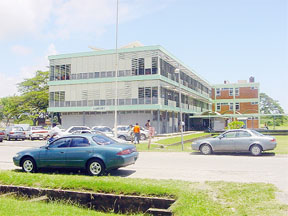The University of Guyana’s 2009-2012 Strategic Plan has cited limited resources for research and the low level of output as one of twenty-six “weaknesses” that continue to impact on its effectiveness, publicly acknowledging in the process a critical deficiency identified during its discourses with the private sector earlier this year.

Both University of Guyana Vice Chancellor, Lawrence Carrington and private sector officials with whom he has met have acknowledged the importance of the university in driving research that can benefit the business sector but have acknowledged that funding to undertake such research was lacking. The University’s strategic plan identifies “under-financing” as the institution’s “greatest weakness” pointing out that its failure to undertake relevant research further threatens an already “fragile national economy.” Chairman of the Private Sector Commission (PSC), Captain Gerry Gouveia, who is one of a group of private sector officials charged with creating mechanisms for the strengthening of relations between the university and the private sector told Stabroek Business that “the university’s public acknowledgement of its several weaknesses is a useful starting point for taking the process forward.”
And President of the Guyana Manufacturing and Services Association (GMSA), Ramesh Dookhoo, who heads a private sector group that has been mandated to interface with the university in an effort to realize a closer working relationship with the institution and the business sector told Stabroek Business that the private sector “both applauds and supports” the Strategic Plan. “All of the elements contained in the Plan are essential to the building of a strong University,” Dookhoo told Stabroek Business. The content of the Strategic Plan which Dookhoo hinted was strongly influenced by the Vice Chancellor essays an uncharacteristically frank assessment of the problems that have contributed to the underachievement of the institution. The substantive lack of funding apart, the Strategic Plan also points to other long-standing weaknesses linked to the university’s funding woes. Student tuition fees, it says, are “below the economic level.” Views expressed by both the Vice Chancellor and private sector officials earlier this year have pointed to the desirability of greater private sector involvement in funding the tuition fees for its employees in order to provide a greater measure of support for the institution. The idea of private sector sponsorship of university tuition for employees has also been linked to helping to arrest the ‘brain drain and high rate of skilled migration”, another weakness of the university identified in its Strategic Plan.
Dookhoo told Stabroek Business that part of the focus of the current collaboration between the University and the private sector was to work together to find ways of funding the institution without setting fees at a level that makes tuition unaffordable. “I believe that it may well be possible to address the funding issue without creating a situation in which fees are raised to an unacceptable level.”
This newspaper understands that the Vice Chancellor is due to meet with President Bharrat Jagdeo early next year to discuss funding and other issues relating to the running of the University.
Meanwhile, the Strategic Plan also identifies “insufficient learning resources, including laboratory and ICT equipment and library holdings” as one of a number of “secondary negative effects” arising out of a lack of funding. Local private sector institutions including the Guyana Telephone and Telegraph Company (GT&T) have contributed to equipping the university with ICT equipment. However, the institution’s ability to provide adequately for its equipment needs has long been stymied by inadequate operational and capital budgets.
Dookhoo told Stabroek Business that since the establishment of a relationship between the private sector through the PSC and UG, the private sector had identified a number of areas in which it could benefit from collaboration with the University. “There are some disciplines like Accountancy, Marketing and Human Resources Management where there are definite weaknesses in the private sector and where we believe the University can help. One of the things that we need to think through, however, is determining how the University can enhance its own capacity to offer the private sector these services,” Dookhoo said.




